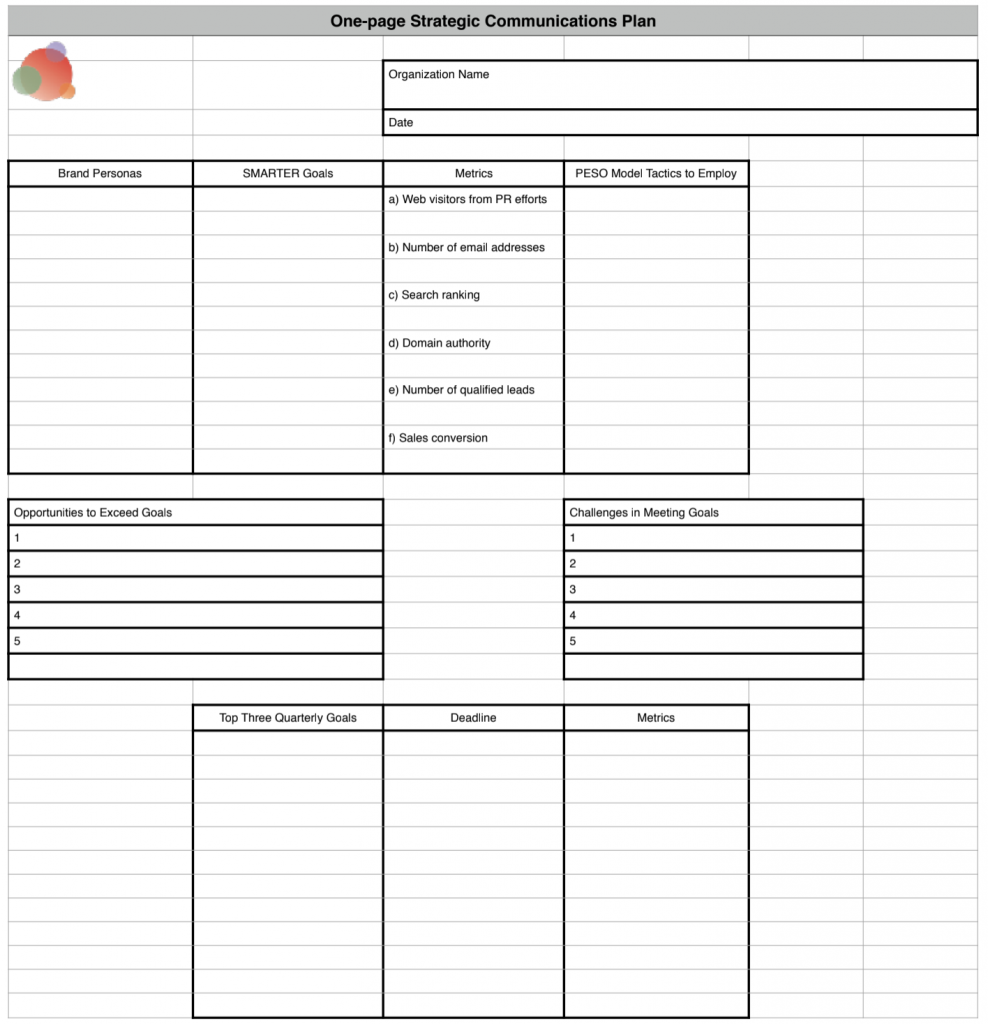 Guess what time it is? It’s planning season and this means it’s time to begin to think about your marketing and communications plans for 2021. I know how incredibly challenging it is to try to plan anything these days, but we have a foolproof way of doing it in 90-day increments, which is completely doable for the time we’re in right now.
Guess what time it is? It’s planning season and this means it’s time to begin to think about your marketing and communications plans for 2021. I know how incredibly challenging it is to try to plan anything these days, but we have a foolproof way of doing it in 90-day increments, which is completely doable for the time we’re in right now.
Who here can think about the next 10 years? How about five? Three? Heck, a year from now? Hahahahahaahah! Good luck! I’m just trying to get to December 18 when I can take two weeks of the year off and build some things around my house.
This has been the craziest year ever and trying to plan even a week in advance has been incredibly challenging. But there is an answer!
That answer is Traction: Get a Grip On Your Business. Anyone who has spent any time with me, from a business perspective, knows I’m a huge, huge Traction fan. The book (and the EOS system, which you can implement) is a necessity for any planning.
Buy and Absorb “Traction”
If you haven’t read it, I highly recommend you stop reading right now and go over to Amazon and buy yourself a copy. I really should do some sort of affiliate code to get a bonus from recommending it, but I’m too lazy. Go buy it! After you finish reading this, you’ll want to read the book. And then implement it. Don’t just let it sit on your shelf or on your Kindle and not do anything but collect dust. Trust me on this.
The book is written for business planning, but the same process works for your marketing and communications planning. When you read it, it’ll be through a business lens. I’m going to talk to you through how to use it for marketing and communications planning.
For the most part, plans are written either with a lot of focus on the next 12 months without any strategic foresight. They’re typically a list of tactics with dates assigned to them. And then the plan gets shoved in the proverbial drawer, neve to be seen from again because things didn’t go according to plan and the list of tactics had to be revised.
That is going to happen every time if your “plan” is a list of tactics. I guarantee it. Instead, you should take a strategic approach to planning this year—and then it won’t matter what the tactics are; you’ll still have success.
There are eight questions the book requires you to think through, plan for, and work with your leadership team (even if your marketing or communications team is just you and the dog) to get onto paper.
Core Values
What are the core values of the organization? What values does your marketing or communications plan need to communicate internally and externally? Has anything changed since earlier this year when consumers began to require organizations to take a stand for social justice?
Core Focus
What is your core focus? Again, you need two answers: one for the organization and one for your marketing or communications plan. This will include who your target audience is, a list of prospects by title and industry, which products or services are key to success for 2021, and anything new, such as pricing, product launches, or evolution of what already exists.
The Next 10 Years
What is your 10-year target? While a 10-year target is extremely challenging right now, you can still think through what success looks like a decade from now.
I serve as the chief marketing officer for a start-up and their founder and I had a big pow-wow last week. He challenged me to think about what a $100MM business does well, from a marketing perspective, and what that looks like for them right now and in the future.
They may never reach that revenue number, but thinking about where we are right now and how marketing needs to evolve to support a business that big is a great way to think about your 10-year target.
Marketing Strategy
What is your marketing strategy? This is all you! What do you need to achieve next year? Is it marketing leads? Marketing qualified leads? Sales qualified leads? All of the above. Another client, where I serve as the interim chief content officer, wants to see how the PESO Model affects all three of those goals. It informs their marketing plan, which informs their sales plan, which informs their revenue goals.
The Next Three Years
What is your three-year picture? Now that you have answers to the four questions we’ve already discussed, it’s time to think about what success looks like three years from now.
Your 2021 Plan
What is your one-year plan? And now as you leave 2021 and go into 2022. Hopefully, success looks like there is a vaccine and we can all see one another again, but from a marketing or communications perspective, what does it look like? The aforementioned client who has us track MLs, MQLs, and SQLs has a very specific number in mind, which we created from success from the last 90 days and projecting an improvement. You can do the same.
Quarterly Rocks
What are your quarterly rocks? These are the things you absolutely have to achieve in a 90-day period, no matter what. It allows you to stay laser-focused on goals and not get waylaid by the shiny, new toys or the next big idea. The rocks can change every quarter, but they need to stay the same—and achievable—for 90 days.
Challenges to Reaching Goals
What are your issues? An issue is an unresolved problem, idea, or opportunity. There is only one reason your marketing or communications plan wouldn’t have any of those: you’re out of a job. You will always have issues. You may solve one issue—and that’s great. But you’ll have more to address. What are the issues you need to address right now to be able to achieve your goals for the next 90 days? It might be upgraded software or a new hire (or 10 or), additional budget or more time, or a better product or rebranding or a better way to track results. Whatever it happens to be, get them down on paper.
Use a One-Page Quarterly Plan
Those are super easy questions to answer, right? Ha!
I have a coaching client who started this process 60 days ago and she’s been whittling away at it since then, with the goal of finishing it before Thanksgiving. It’s something that takes time and lots and lots and lots of conversations with your team—or yourself and your dog. If you start now, you’ll have a beautiful plan before the holidays, and can start the new year in a great place.
Now that you have answers to all of those questions and they’re likely on post-in notes, in notebooks, and in documents or slide decks, now it’s time to pull it all together into one place: the one-page quarterly plan.
This one-page quarterly plan allows you to see what your goals are for the year and the next five years, but more importantly, what you need to do in the next three months to move you toward those larger goals.
It drives your core values and your purpose and it allows you to ask the questions during every leadership, board, agency, and/or team meeting, “What are we doing exceptionally well” (this would be opportunities to exceed goal) and “What are we missing?” (this would be threats to making goal).
On the one-pager, you’ll find your organization’s name and the date (the date should change each quarter)—and then a place for you to write answers to all eight questions, and then some.
It allows you to get all of these answers and thoughts into one place, on only one page. There are two things you want to add that you haven’t already thought through: deadlines and resources that will allow you to achieve your goals.
Planning Takes Discipline
Though your draft document as you plan may be 30 pages in a Google doc or several pages in a notebook or lots and lots of post-it notes or a carefully curated whiteboard, you’ll narrow it down to only one page.
The idea here is to not write a plan so large, you never go back to it, so if it actually turns into two pages, that’s OK. The idea is to drill it down into something that can sit on your desk for reference daily. You want to work against it every day and you can’t do that if it’s 30 pages.
It’s not easy work and it does take a lot of time—time that not everyone, including leadership or clients, may not want to take, but if you want to execute well and have results in 2021, it’s imperative you do this work now.
The real test is in your execution, but this process sets you up really well for success. I challenge each and every one of you to do this—regardless of you being internal or on the agency side. Then let’s talk about all your Q1 success in April. That will be something to celebrate!
If you need help with this process or want to brainstorm ideas, join us in the Spin Sucks Community. We’d love to help!
Photo by Glenn Carstens-Peters on Unsplash
